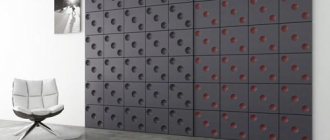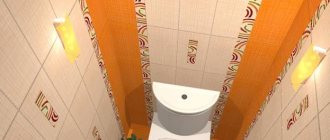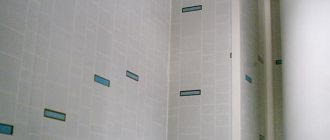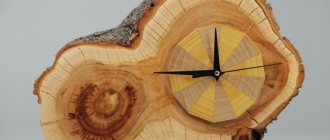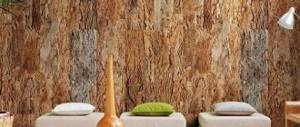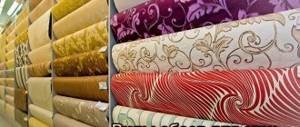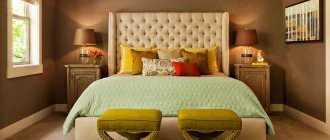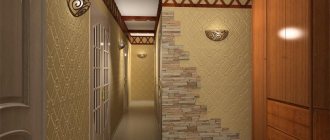There are a considerable number of finishing materials for decorating walls, although it is difficult to find environmentally friendly and durable material. Increasingly, finishing walls with cork attracts consumers due to its soft texture to the touch, its minimal weight, and water-repellent properties. The monotony of the pattern can be easily compensated for by modern methods of painting walls.
House interior decorated with cork panels
When choosing a brand and manufacturer of cork, choose domestic ones, for example, Granorte, Viscork.
Characteristics of cork coating
Before you start decorating the walls, pay attention to the characteristics of the cork covering. It is especially important if you plan to repair walls in rooms where there are high temperatures and high humidity.
The use of cork material on the loggia
Advantages
Positive features of wall finishing with cork:
- consists of natural ingredients and environmentally friendly ingredients;
- antistatic, does not leave dust during installation and operation;
- does not absorb unpleasant odors;
- minimum weight;
- elastic, resilient;
- moisture-resistant, therefore prevents the appearance of mold and mildew;
- has low thermal conductivity;
- quite durable and wear-resistant;
- does not cause allergies;
- excellent sound insulator;
- does not support combustion;
- after any load it restores its shape.
Some positive characteristics appear only if all the walls in the room are finished.
Flaws
In addition to the positive properties, cork also has disadvantages that must be taken into account when purchasing this material:
- under the influence of ultraviolet light the color of the material changes;
- considerable cost;
- It is better to entrust finishing to specialists.
Knowing the disadvantages of cork material, it is not difficult to avoid troubles during wall repairs.
Advantages of cork and scope of application
A wall treated with this material looks truly luxurious. You can decorate any room with cork: it could be a living room, a hallway, or even a bath.
This is due to the advantages of cork:
- compactness, light weight, because cork is a light and buoyant raw material;
- strength: cork has a high level of wear resistance; as a result, the cork coating is more durable, it does not fade under the influence of sunlight and, with proper use, wears out slowly;
- does not emit toxic substances, this is an environmentally friendly way to decorate your home;
- cork has soundproofing properties;
- perfectly masks the imperfections of the surface being decorated;
- moisture and gas resistance: the cork does not allow moisture or gases to pass through, thereby minimizing the appearance of mold;
- cork is a fireproof material that does not support combustion;
- low thermal conductivity, so in winter cork wall decor will help retain heat;
- decorating the walls will not take much time and effort.
Cork will harmonize perfectly with any color scheme and will translate all your design ideas into reality without difficulty. Read my article about what to do next with the cork.
Kinds
Considering the characteristics of cork coating, do not forget to pay attention to its types.
The following types of cork material are known:
- wallpaper;
- slabs;
- rolls;
- liquid plug;
- technical jam.
To choose the right option, before purchasing, you need to study all the features of different types of cork material, determine the amount and durability.
Wallpaper
The cheapest option for wall decoration is cork wallpaper. When creating them, they use paper, which is coated with varnish and veneer.
Cork wallpaper in the interior
If desired, such wallpaper can be combined with conventional, other methods of wall decoration. They are easy to glue due to their elasticity and lightness. They can last about 10 years.
Price 1 sq.m. 550 -1265 rub.
Plates
Cork slabs contain 2 layers and granulated cork. The desired shape and texture are achieved using pressing.
And for strength, such a slab is covered with a layer of wax, which protects the slab from damage and moisture, the service life is 10-30 years.
Rolls
Like slabs, rolls consist of 2 layers: one is pressed cork, the second is veneer. But the rolls are thicker and more elastic; they can be combined with cork wallpaper, even for the kitchen, because they are moisture resistant. If you use cork material correctly, it will last about 20 years.
Price 1 sq.m. — 520 — 1145 rub.
Liquid plug
A special mixture of cork chips and acrylic is the basis of liquid cork. The material is moisture resistant and provides excellent sound insulation for the room.
Liquid cork is sold in tubes or buckets and can be used on any surface indoors or outdoors.
Sometimes liquid cork has fire-resistant properties.
Technical traffic jam
This type of cork serves as the basis for the use of finishing material. Technical cork protects the wall from negative factors. Service life This material is the most durable and will last indefinitely.
Rolled technical plug
The material is ideal for decorating corridors and hallways; cover the cork with varnish - then there will be no dust or dirt.
Is it possible to put cork on the walls?
The material successfully imitates cork wallpaper and is advantageous to use for decorative wall decoration for economic reasons. But it was created for other purposes, so it’s natural to ask the question: is the technical characteristics of a cork backing suitable for a wall instead of wallpaper?
The coating has the following properties:
- environmentally friendly and safe (90% consists of natural recycled products and does not contain chemicals harmful to human health);
- good soundproofing and thermal insulation characteristics;
- high compression ratio;
- moisture resistance;
- fire resistance (without the release of toxic gases);
- absence of static electricity.
Cork ? durable material that retains its attractive appearance for many years. The elastic structure of the coating allows it to successfully withstand mechanical stress.
Having analyzed the performance qualities of cork substrate, we see that it is suitable for decorative purposes and is a good choice for wall cladding in both residential and public spaces.
Step-by-step instructions for finishing walls
Although it is better to entrust the finishing of walls with cork to a specialist, you can do this work yourself. Just follow the step-by-step instructions exactly.
Set of tools
Before starting work, prepare the following tools:
- level and plumb;
- assembly scissors;
- iron ruler;
- notched spatula;
- velor roller;
- seam roller;
- container for glue.
A day before starting work, unpack the material and leave it in a warm room to get used to it so that it does not unexpectedly change in size during installation.
Cork glue
Choose glue, preferably contact or acrylic. Using tools, determine the center of the wall, draw lines that will be visual boundaries for the cork material.
Preparing the walls
Although cork material does not require ideal preparation of the wall surface, for the best result the walls will have to be leveled, primed and cleaned of dirt and old material before work.
Fastening
The cork covering is secured using glue. It must be applied in an even layer, then glue the tile to the wall. To avoid bubbles, start from the bottom of the tile, smoothing it thoroughly. Wait for the cork to stick, then go over it and along the joints with a roller.
Gluing cork tiles to the wall
In the corners, near sockets and switches, the tiles will have to be cut.
If you choose cork wallpaper, you must remember that a very thin layer of glue is applied to the paper base, only on non-woven paper it is thicker.
Decoration
At the last stage, decorate. If you plan to make an ornament or pattern, use several cork tiles of different colors. Select additional materials, such as mirrors. Some cork materials can be painted.
Cork on the wall in different tones
Tinted coatings are chosen for rooms that are located on the south side.
Interlocking and adhesive cork materials are widely used in the form of collages of tree species, which will add eco-style features to the interior.
Finishing the balcony with cork
Many owners want to change the microclimate of the loggias, since the lack of heating here and the temperature difference have a beneficial effect on the appearance of dampness and fungus. Finishing the balcony with cork is an ideal option for such rooms. This material will make the room dry and warm.
Decorating the balcony with cork gives an interesting look to the interior
The materials you can use, for example, are cork wallpaper, but you will have to buy the thickest ones, because thin ones can only be used on dry balconies. Pay attention to choosing the right adhesive.
Modular panels or double-sided tiles on cork chips are suitable for the loggia.
Read more about cork in the interior
What types of cork wall panels are there in terms of design, size and quality?
Cork wall panels come in 2 types:
- Stacked, their width is from 100 mm, their length can reach 6 meters.
- Tiled ones with dimensions from 300*300 mm... 980*490 mm.
And in addition, cork wall panels can have a solid top layer or made of pressed chips, which greatly changes the price of the material. The usual thickness is 3-4 mm, but some manufacturers have panels of 30-60 mm.
The natural color of cork is very expressive, but it is not suitable for all design solutions. The market has adapted to demand, and now you can buy panels painted in different colors, usually in a calm, pastel palette, which retain the beautiful texture of the material. There are also models interspersed with glass or metal chips, with inlay and applique of various ornaments.
What types of cork coverings are suitable for gluing to walls?
Cork wall coverings come in several types and different thicknesses, and additional parts are also provided for them: corners, glazing beads, joining strips.
The choice of coating directly depends on the specifics of the room and the functionality with which it will be endowed. If good sound insulation in a room is required, then the interior decoration should be multi-layered; rolled cork covering for walls will come in handy here. Usually the first layer is made of agglomerate or plasterboard, the second is cork, and the top is finished with veneer. The difference in material density provides a difference in sound vibrations, and this reduces the resonance frequency.
For thermal insulation, it is optimal to use sheet material. If cost is important, then cork wallpaper is preferable here; their price is much lower than other cork materials, but they are not inferior to them in aesthetics, and stickers do not require any special skills.
What nuances are covered in wall paneling?
The walls must be smooth, dry, free of dust and oil stains.
It is important to know that cork does not tolerate dry air well, therefore, in order for the finish to lay flat, it should be glued at a humidity of 40 to 60%. There are 2 types of glue for this coating: acrylic and contact; installation on it is more durable, but you will have to coat both the cork and the surfaces.
It is impossible to remove the newly glued plug or move it if it is skewed with glue, so the walls are pre-marked. It is important to mark strictly vertical lines along which the edge of the wallpaper will go.
If the material is rolled, then it is glued end-to-end, and if it is sheet, the photo below, finishing the walls with cork is done with the seams spaced by half or a third of the tile, then the joints will be almost invisible.
Is it possible to install cork wall coverings in the bathroom?
It is not recommended to use cork in rolls in damp rooms; in the bathroom it is permissible to glue only sheet material, in no case tongue-and-groove. Cork boards do not absorb moisture, which ensures a stable geometry of the material. Decoration is done with 4 mm thick slabs that can be varnished. The wall plug is installed in damp rooms using contact adhesive.
If you read the reviews, many craftsmen claim that cork can be used anywhere, on the balcony, on the loggia, and in the toilet; the material does not absorb odors, but not in the bathroom. As an argument for having a cork in the bathroom, we suggest looking at bottle caps or the lid in a thermos. The material is preserved perfectly in a liquid environment, but in order for it not to lose its aesthetic appearance, for finishing it will be necessary to apply 3 layers of elastic varnish, preferably a two-component one with a hardener, as a result the surface will correspond to wear resistance class 32.
What materials go best with cork in an apartment interior?
Designers recommend covering entire walls with cork with only a monochrome texture; it will not ripple and clog the rest of the interior of the room.
If a variegated texture is taken as the basis, then it must be diluted, for example, with smooth plastic panels, wood, or decorative plaster. If the hallway is being finished, then cork is usually combined with stone.
Very often, cork in the interior, photo below, is combined with the same material, but contrasting in color and texture. For example, walls are covered with a variegated texture, and openings or arches are covered with cork with a relatively monochrome surface, or the wall is divided by a curved line of different colors. Of course, drawings, patterns, and ornaments made from different types of cork also look impressive.
What kind of glue is there for cork on walls, and how to apply it correctly?
The most popular types of glue for cork wallpaper:
- a mixture of polychloroprene with the addition of synthetic rubber;
- latex-acrylic dispersion composition, without the use of solvents;
- contact adhesive solution based on polychloroprene, it is recommended by almost all cork manufacturers.
Acrylic glue is thick, and it is applied with a special notched trowel, and only in place of laying one tile; in general, the process is similar to installing tiles.
It is important to know that before gluing wallpaper, the package with the cork should be opened, cut into strips and allowed to rest in the room for at least a day. It is not recommended to glue cork onto PVA.
Which cork flooring is best to buy for an apartment?
For home decoration, it is recommended to purchase cork wallpaper on a paper basis; this option combines the best price/quality ratio, they are environmentally friendly, are not afraid of moisture, and are quite easy to care for. They are glued using the same technology as other heavy wallpapers; the surface does not require special preparation.
But few people know that cork wallpaper for walls comes without finishing or coated with wax. The first ones have a porous texture, absorb odors and moisture, and therefore are suitable only for living rooms: living room, bedroom, nursery. In utility rooms such as the kitchen and toilet, wax-impregnated wallpaper should be used.
Expert advice
Sometimes there are gaps between the parts of the cork. To avoid them, you need to attach the edges to the wall so that the sheet becomes curved by approximately 4 mm, then run a roller over the surface, pressing the sheet or tile into the desired space. In this case, the walls will look perfect.
Although environmentally friendly cork is not a cheap option, it is so practical that buyers appreciate it. If you follow all the rules for decorating walls with cork and know its properties, it is quite possible to turn the interior into a comfortable zone with your own hands, which will delight the owners for a long time.
